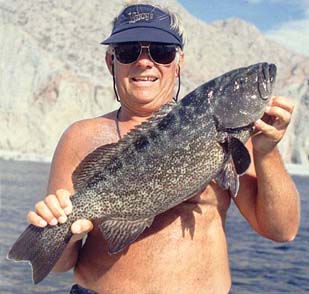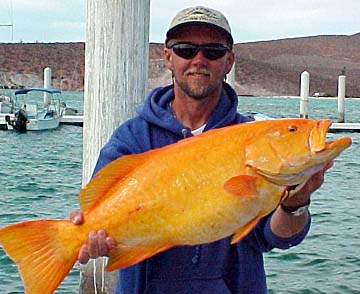
Golden Grouper: Baja’s Queen of the Sea
![]()
BAJA CALIFORNIA: THE COLOR-CHANGING GOLDEN GROUPER (GOLDEN CABRILLA)
|
At left, a "standard issue" leopard grouper, Mycteroperca rosacea, and at right, the same species of fish in its rare golden color phase. |
Golden Grouper: Baja’s Queen of the Sea
Jan. 15, 2005, by Gene Kira, as published in Western Outdoors Magazine:
While fishing on a pleasant June afternoon in Baja California's Sea of Cortez many moons ago, I was bobbing around the northeast corner of large Isla Angel de la Guarda, dropping bait down the face of an underwater cliff in hopes of catching a huge jewfish or black sea bass--when instead, I accidentally caught my first “golden grouper.”
As that brilliant orange-gold shape swirled upwards in the late afternoon shade of the island, I at first imagined that it was a huge goldfish or Japanese koi, the ornamental carp so popular in the world’s fish ponds.
But of course, that was impossible in salt water, so I then decided it had to be a freak catch of a really humongous Pacific coast garibaldi, the small, perch-like Hypsypops rubicundus, which up until then was the only other fish I had ever seen with such a spectacular, total, Day-Glo orange paint job.
|
|
When it reached the surface of the jet-black but oddly pellucid water, the bright orange fish seemed ever more magical, ever more beautiful, as I began to reel it in and reach for the gaff. And gaff it I did, to my everlasting regret, for it turned out to be the largest example of only half-a-dozen “golden groupers” that I’ve caught in four decades of fishing on the Sea of Cortez.
Since that lovely afternoon on the Sea of Cortez Midriff area’s protean, forever unfamiliar waters, I’ve always been fascinated by these rare golden groupers, which are not really a distinct species, but are rather an uncommon genetic subset of a very common Baja fish, the ubiquitous Mexican “cabrilla,” Mycteroperca rosacea, more properly called the “leopard grouper” in English.
These normally drab, brownish-colored leopard groupers or “cabrillas” are the Baja’s dominant, bread-and-butter, inshore reef fish of the southern two-thirds of the Sea of Cortez. They grow to about three feet long, and about twenty-two pounds in weight, and they are the basic “ice chest fish” from the Cortez Midriff, all the way around Baja and up to about Bahía Magdalena on the Pacific coast.
The leopard grouper--with its characteristic squared-off tail--is a true grouper and not a round-tailed “cabrilla” as its Mexican name would imply, an etymological inconsistency that causes endless angst among the more pedantically inclined among us, but which doesn’t seem to bother Mexican fishermen in the slightest. In fact, the leopard grouper is called by all kinds of Spanish names, including the “cabrilla,” “sardinera,” “cabrilla pinta,” “calamarera,” and “reina”--the last of which refers to the mysterious, amazingly-colored golden phase of this species.
(It is perhaps a folkloric testament to the singular beauty of the golden grouper that Mexican pangueros call it the “reina,” or “queen” in Spanish, as opposed, for instance, to the name “vieja,” or “old woman,” given to the homely, hump-headed hogfish.)
Although scientific “facts” about Baja’s golden grouper are hard to come by, there are probably more anecdotal stories and legends swirling around it than any other Baja fish. The most fantastic of these stories describe such things as golden groupers saving lost divers or leading them to chests full of Spanish treasure, or, probably the most outlandish of all, Ray Cannon’s 1960s tales of golden groupers using their bright coloration intelligently to “herd” bait fish toward schools of their well-camouflaged, brown-colored brethren.
As Cannon described his observation of this phenomenon during a trip to Isla Cerralvo near La Paz: “It was the weirdest sight in all my fishing experience. I’m still shaken by it. I can’t make myself believe that fishes could display intelligence...”
Indeed. Even today, references to this putative “intelligent herding” behavior are repeated without qualification by some sources that should know better; suffice it to say this theory has never been scientifically confirmed.
Recently, however, I’ve received some authoritative and very interesting information about the golden grouper from Neff Nash, a researcher who has studied the Serranidae family of groupers and basses extensively and who consults with Donald A. Thomson, co-author of Reef Fishes of the Sea of Cortez.
Golden groupers are morphologically identical to regularly-colored leopard groupers, and in fact, they all start out with the same drab, brownish skin. But, when they are about ten inches long, roughly one percent of the fish become “star-struck” and suddenly change to gold.
My own observations and photographs taken over the years, seem to indicate that this color transformation is extremely sudden. I have neither heard of nor seen photos of any “orangish-brown” fish. None that I’ve ever heard of has been caught during the transition process. That is, virtually all golden groupers, by the time they are observed, have already turned into a solid, bright, pure orange, from stem to stern.
(There is only one exception to this situation that I know of. Very, very rarely, a few golden groupers seem to “get stuck” during the color transition. These fish have permanent areas of regular brown, and other areas of pure gold, with perfectly sharp borders between the different colors. I’ve never seen a fish with golden tones blended into the brownish-olive background color. For any given patch of skin, it’s either all-gold or all-brown.)
Although, according to Nash and Thomson, about one percent of regular leopard groupers will turn golden, my empirical observation indicates that the percentage of golden groupers actually caught by anglers is somewhat less, perhaps closer to one-half of a percent. Whether that means anything or not is open to question.
|
|
In any case, the sudden change, once made, is permanent for life, i.e., golden groupers do not revert to the normal color phase, and the special coloration is not related to gender, i.e., half of golden groupers are female, and half male.
All of this, of course, leaves us with the extremely intriguing question of why such a small proportion of all leopard groupers should change color so radically. What possible evolutionary advantage could be gained from making only one percent of both males and females so brilliantly visible? In other words--except for making an excellent story--what good is it?
Nash notes that the golden grouper’s color transformation, while unusual and interesting, is not unique: “Too many people place special significance on this color phase. The sailfin grouper (Mycteroperca olfax) has the same golden phase. They clearly share the same gene.”
The purpose, if any, of the golden grouper’s color transformation may never be determined (maybe Ray Cannon was right after all!), but regardless, it is indisputably one of the most beautiful fish that ever graced a sea; this is a truly deserving “reina” that is often released alive, even by Mexican commercial pangueros, who are not known for sentimentality when it comes to securing dinner for their families.
The respect that Baja’s pangueros have for the golden grouper is an example for us all, especially those few tourist anglers who, like me, have thoughtlessly killed one without knowing of its rarity. May the beauty and special status accorded this “queen of the sea” be an inspiration for the preservation of all fish, and their deep and wide domain. Long live the queen!
(Related Baja California, Mexico, articles and reports may be found at Mexfish.com's main Baja California information page. See weekly fishing news, photos, and reports from the major sportfishing vacation areas of Mexico including the Baja California area in "Mexico Fishing News.")
MEXICO FISHING INFO BAJA FISHING INFO "WEEKLY MEXICO FISHING NEWS" FISH PHOTO GALLERY

